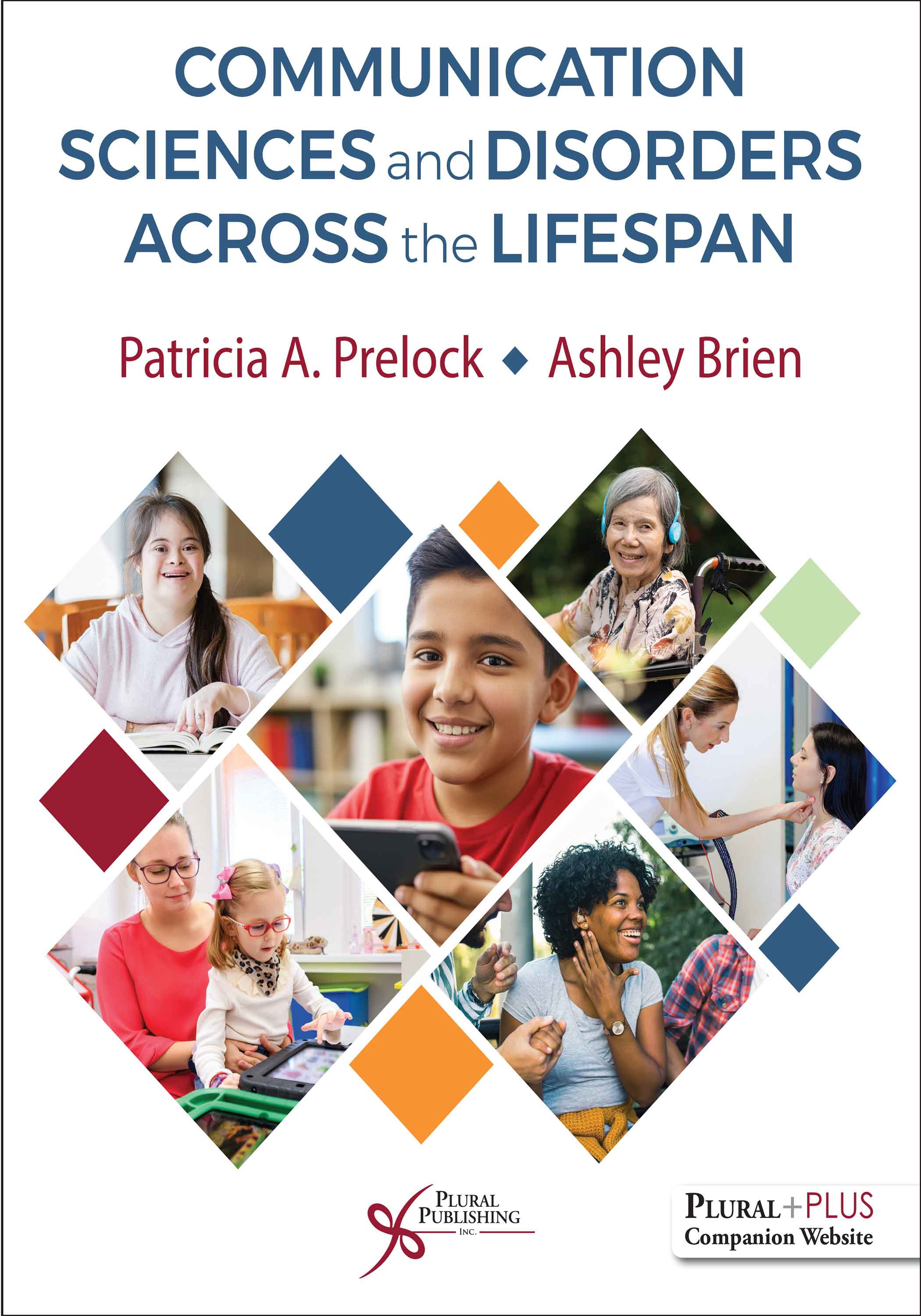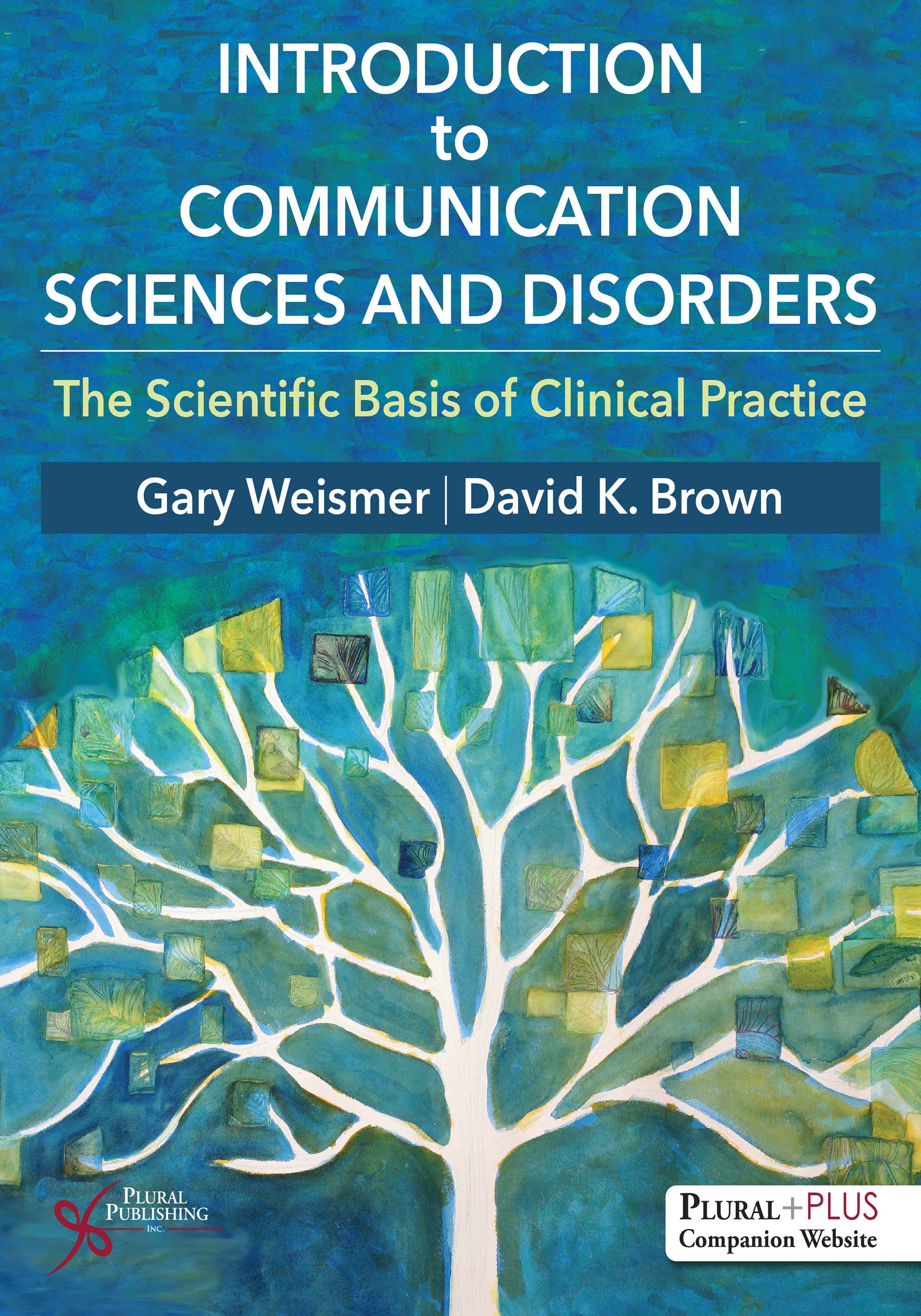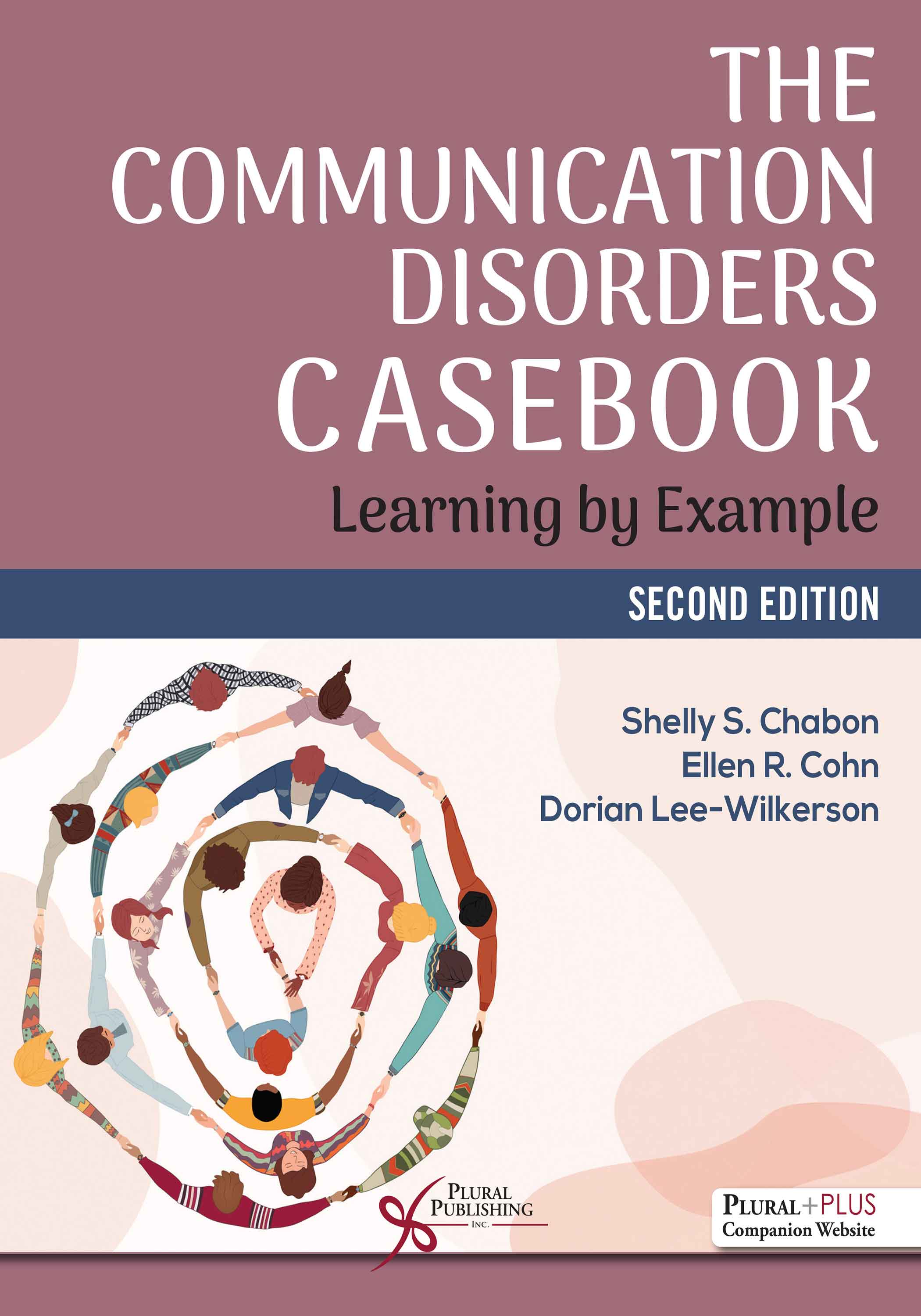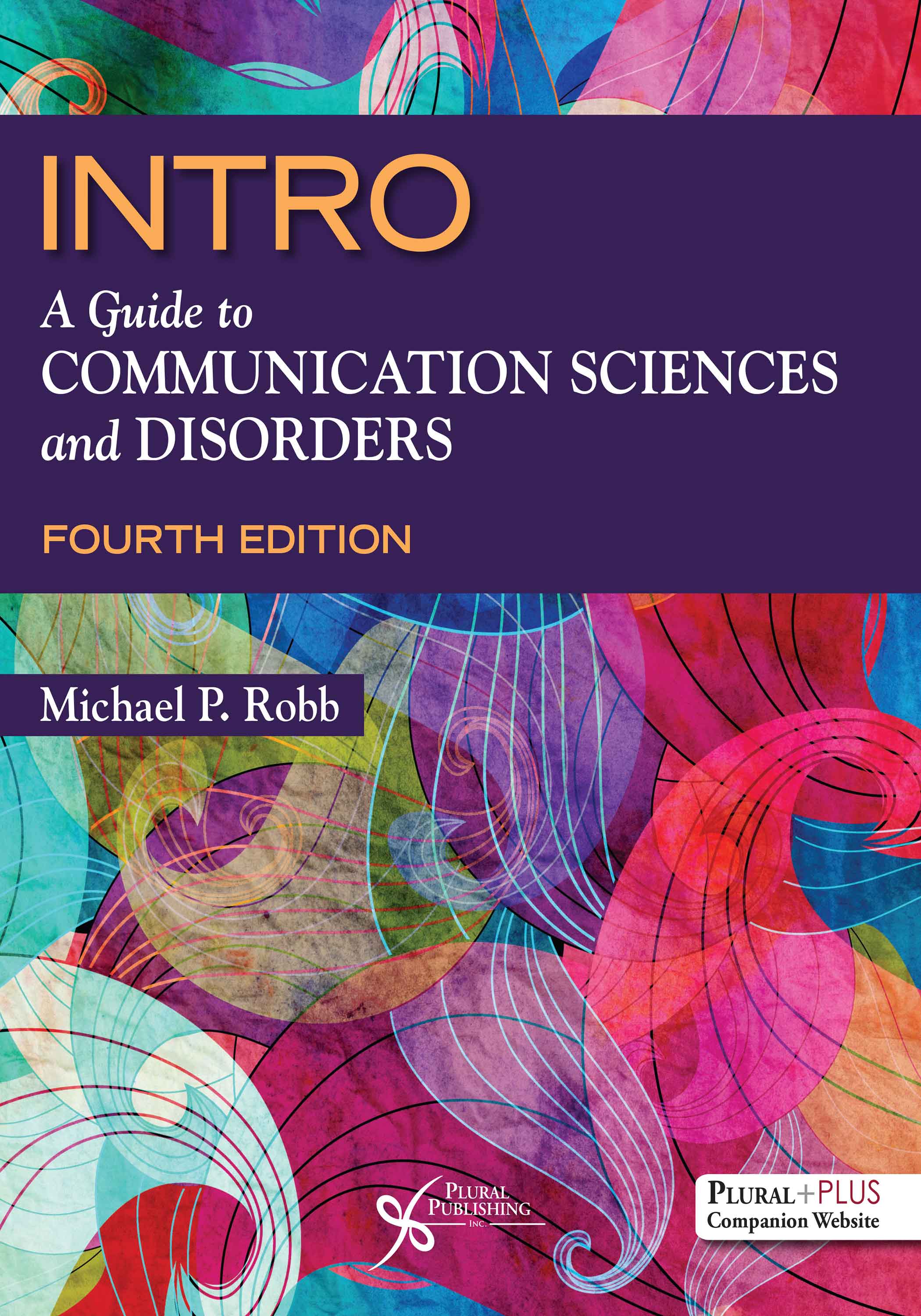
Communication Sciences and Disorders Across the Lifespan
First Edition
Patricia A. Prelock, Ashley Brien
Details: 487 pages, Full Color, Softcover, 8.5" x 11"
ISBN13: 978-1-63550-453-8
© 2026 | Available
For Instructors
Purchase
Designed for undergraduate students beginning their educational journey in communication sciences and disorders, this comprehensive new introductory textbook delves into the intricacies of human communication, providing a thorough understanding of the disorders that can impede this vital function. Written by authors with extensive experience in both academic and clinical settings, Communication Sciences and Disorders Across the Lifespan covers the professions of speech-language pathology and audiology, the concept of disability, anatomy and physiology of speech and hearing, speech and language development, overviews of the various communication disorders across the lifespan (speech sound disorders, motor speech disorders, pediatric language disorders, learning disorders, literacy impairments, adult language and communication disorders, stuttering, voice disorders, hearing disorders), AAC, evidence-based practice, and research. Case studies are integrated into the text to illustrate the application of theoretical concepts in clinical settings. The authors have created a comprehensive, current, and pedagogically rich resource that stands out for its innovative learning tools and unique chapters, ensuring a well-rounded and engaging experience for students with different learning styles. The text comes with ancillary resources for both instructors and students on a PluralPlus companion website.
Unique Content
- Disability Across the Lifespan: Comprehensive chapter on the broader context of disability, its history, models, and intersectionalities with race, gender, age, and socioeconomic status. It also discusses ableism, accessibility, and disability rights in the U.S.
- Understanding Research and Evidence-Based Practice: This chapter provides an in-depth look at research methods, types of research, and the importance of evidence-based practice within the field of communication sciences and disorders.
- Specific Learning Disorders: A dedicated chapter addressing learning disorders and literacy impairments, including reading, writing, and math disorders.
- Content related to Cultural and Linguistic Diversity is woven throughout the text instead of in a dedicated chapter.
- The authors compiled a multitude of additional readings, websites, and videos made easily accessible with QR Codes in the margins.
Key Features
- Engaging: Complex theories and concepts are presented in an accessible and engaging manner, and figures and illustrations are in full color.
- Current and Relevant: Integrates the latest research and clinical practices to ensure students are learning the most up-to-date information.
- Practical Application: Emphasizes real-world application of concepts through case studies, clinical examples, and learning activities.
- Interactive Learning: Features learning activities and links to multimedia resources to further enhance understanding and retention.
- Robust Pedagogical Features:
- Learning Objectives and Key Terms: Chapters begins with a concise list of learning objectives and key terms that outline the key information students should master.
- Figures, Tables, and Photographs: The full-color art program includes detailed anatomical images, photos, charts, and tables that aid in understanding complex concepts.
- QR Codes: Websites and videos are easily found by using QR Codes in the margins.
- Case Studies: Real-world case studies are integrated to illustrate the application of theoretical concepts in clinical settings.
- Clinical Examples: Examples from clinical practice are interwoven throughout the text, providing context and relevance to the material. These examples help students connect theory to practice and understand the real-world significance of their studies.
- Research Highlights: Sections within each chapter highlight current research and advancements in the field. These highlights emphasize the importance of evidence-based practice.
- Pause and Ponder Boxes and Discussion Topics: Thought-provoking discussion topics encourage critical thinking and class participation. These topics are designed to stimulate deeper understanding and engagement with the material.
- Summary Sections: Each chapter concludes with a summary that recaps the key points covered. This helps reinforce learning and provides a quick review for students.
- Review Questions: At the end of each chapter, review questions encourage students to reflect on and apply what they have learned. These questions reinforce key concepts and provide an opportunity for self-assessment.
- Annotated Bibliographies: Curated to provide the most relevant and up-to-date sources in the field.
- A comprehensive Glossary and Index at the end of the book offer quick reference and reinforcement of the key terminology.
PluralPlus Online Ancillaries
For instructors: PowerPoint Slides, Test Bank, Instructional Outlines, Class Activities, Case Studies, Video Links
For students: Quizzes, Study Guides
Reviews
“The themes of cultural considerations, health care disparities and DEI are woven throughout. …The content has a nice balance of milestone research (e.g., Brown’s table, Sander’s consonant development graph) with current research. …The authors’ writing style is very approachable. Most chapter introductions start with a question directed to the reader which is a great hook: “Have you ever been at a football game cheering for your team with such energy that you have lost your voice? Do you know a singer who had to cancel a show because they lost their voice?” …The resources included in each chapter allow for an instructor to go deeper into topics depending on circumstances. These resources also give students opportunity to 'customize' their learning since each student will have a different set of interests. This is a great book for students to keep as a reference moving into through their undergraduate degrees and into their graduate programs.”
— Susana L. Keller, MS, MBA, CScD, Program Director, MS Speech-Language Pathology, Chair, Communication Sciences & Disorders, DeSales University
“The clear strengths of this book are the additional sections that I have not seen in other introductory textbooks, which include the research in the profession, neurodiversity, historical lens of disability studies, and the appendix on how to read primary sources.”
— An Dinh, PhD, Assistant Professor, Speech-Language Pathology, The University of Toledo
“The chapters are well written and consistent in focus. I like that many of the paragraphs are written in a language that welcomes the reader to continue reading the information. …I feel the book is appropriate for those just beginning to study CSD. …I loved the questions and examples at the end of the chapters. One thing that I have not seen in many intro books is a well-written chapter on research. I was especially enthusiastic to see that the authors included how to read a journal article or how to read research. Chapter 2, understanding the history of disability was a refreshing chapter. There are not many ‘intro’ books that will include this topic.”
— Ruth Renee Hannibal, PhD, CCC-SLP, Associate Professor, Department of Communication Sciences and Disorders, Valdosta State University
“This a book I could create or recreate the intro to CSD course around with well broken up sections that align with a typical school schedule. …For students getting acclimated to the major, this meets the need of introductory topics to build upon in further classes. …Prelock and Brien do well to credit the spans of knowledge in our profession in a well-organized way that meets the level for an Introduction to CSD class. The chapters fit nicely into a typical semester length to support organized teaching.”
— Nicole Lewis MS, CCC-SLP, Gannon University
“It is much more '101' friendly in its examples, and the way it hooks in these young readers. …I really like the dysphagia chapter as it is very accessible for beginning students. …The text is very up-to-date, especially for the DEI aspects and inclusion of neurodiversity.”
— Melissa Caserta, MS, CCC-SLP, Instructor/Clinical Educator, Communication Sciences and Disorders, Southeastern Louisiana University
“The content on the history of disability was well written and impactful. …The key takeaways at the end of the chapters along with the definitions and discussion prompts are a nice wrap-up, and will be useful by the instructor for discussion within the class and also for assignment content.”
— Natalie Armstrong, DEd, CCC-SLP, Clinical Instructor, Communication Sciences and Disorders, Pennsylvania Western University
“A standout feature of the textbook is its multimedia approach. QR codes and links to updated web resources allow readers to access real-time information, ensuring that they stay current with evolving research and practices. This is a smart design feature considering the ever-evolving nature of the profession and the preference for online learning material. The learning activities, such as watching videos or reading articles, provide an interactive experience that complements the textbook material and provides further appeal to different types of learners. These multimedia elements, along with the book’s clear and concise explanations, enhance the learning experience available to readers. ...Communication Sciences and Disorders Across the Lifespan is a comprehensive and well-organised textbook that offers a broad and in-depth exploration of communication and swallowing disorders. Its multimedia-rich content, clear structure, and accessible design make it an ideal resource for undergraduate students.”
— Corinne Cribb, in Journal of Clinical Practice in Speech-Language Pathology (April 2025)
Preface
Acknowledgments
Contributor
Reviewers
Using This Textbook
Chapter 1. An Introduction to Communication Disorders and the Professions of Speech-Language Pathology and Audiology
Learning Objectives
Key Terms
Introduction
What We Know About This Topic
What Is a Communication Disorder?
Cultural Considerations
What Are the Career Pathways for Audiologists and Speech-Language Pathologists?
Audiologists
Speech-Language Pathologists
Career Pathways for Audiology or Speech-Language Pathologist Assistants
Research Innovations in Communication Sciences and Disorders
Why Is This Topic Important?
Overview of the Book Chapters
Chapter Summary
Key Takeaways
Chapter Review Questions
Learning Activities
Additional Resources
References
Chapter 2. Disability Across the Lifespan
Leaning Objectives
Key Terms
Introduction
Language Used in This Chapter
What Is Disability?
History of Disability
Models of Disability
Stigmatization
Disability and Illness
Ableism and Accessibility
The Intersectionalities of Disability
Disability and Race
Disability and Gender
Disability and Age
Disability and Socioeconomic Status
Disability Rights in the United States
Why Is This Topic Important?
Chapter Summary
Chapter Review Questions
Learning Activities
Suggested Reading
Suggested Films
References
Chapter 3. Understanding Speech and Language Development
Learning Objectives
Key Terms
Introduction
Early Speech Development
Early Language Development
Receptive and Expressive Language
Phonology
Semantics
Morphology and Syntax
Pragmatics
Late Talkers
Assessment
Intervention
Why Is It Important to Understand Speech and Language Development?
Chapter Summary
Chapter Review Questions
Learning Activities
Suggested Reading
Additional Resources
References
Chapter 4. Anatomy and Physiology of the Speech Mechanism
Learning Objectives
Key Terms
Introduction
Respiratory System
Phonatory System
Characteristics of Voice Production: Pitch and Loudness
Articulatory System
Resonatory System
Chapter Summary
Chapter Review Questions
Learning Activities
References
Chapter 5. Developmental Speech Sound Disorders
Learning Objectives
Key Terms
Introduction
What We Know About This Topic
Risk Factors for Functional Speech Sound Disorders
Incidence/Prevalence of Childhood Speech Sound Disorders
Characteristics of Speech Sound Disorders
Cultural Considerations in Speech Production
What Can We Do to Address This Communication Challenge?
Assessment
Cultural Considerations for Assessing Bilingual Children
Intervention for Childhood Speech Disorders
Intervention Considerations for Culturally and Linguistically Diverse Populations
Why Is This Topic Important?
Application to a Child
Chapter Summary
Chapter Review Questions
Learning Activities
Suggested Reading
Additional Resources
References
Chapter 6. Motor Speech Disorders
With Dorothy Yang
Learning Objectives
Key Terms
Introduction
The Brain
Motor Speech Disorders
Dysarthria
Apraxia of Speech
Cerebral Palsy
Impact of Motor Speech Disorders Across the Lifespan
Cross-Cultural Information
Assessment
Assessment for Adult Populations
Assessment Considerations for Pediatric Populations
Cross-Cultural Considerations in Assessment
Treatment
Treatment for Adult Populations
Treatment Considerations for Pediatric Populations
Why Is This Topic Important?
Application to a Child
Application to an Adult
Chapter Summary
Chapter Review Questions
Learning Activities
Suggested Reading
References
Chapter 7. Childhood Language Disorders
Learning Objectives
Key Terms
Introduction
What We Know About This Topic
Signs and Symptoms of Language Disorders
Incidence and Prevalence of Language Disorders
Causes of Language Disorders
Other Disorders That Share Characteristics of a Language Disorder
What Do We Do to Address This Communication Challenge?
Assessment of Childhood Language Disorders
Cultural Considerations
Intervention for Childhood Language Disorders
Intervention Applications in Cultural Groups
Additional Intervention Approaches
Service Delivery Options
Why Is This Topic Important?
Application to a Child
Chapter Summary
Chapter Review Questions
Learning Activities
Suggested Reading
Additional Resource
References
Chapter 8. Specific Learning Disorders and Literacy Impairments
Learning Objectives
Key Terms
Introduction
What Is a Specific Learning Disorder?
What We Know About This Topic
Incidence and Prevalence of Learning Disorders
Signs of Learning Disorders
Causes of Learning Disorders
Co-Occurring Disorders
Reading Disorders
Written Language Disorders
Math Disorders
Nonverbal Learning Disability
What Do We Do to Address This Communication Challenge?
Assessment
Intervention
Why Is This Topic Important?
Application to a Child
Application to an Adolescent
Chapter Summary
Chapter Review Questions
Learning Activities
Suggested Reading
Additional Resources
References
Chapter 9. Adult Language and Cognitive Communication Disorders
Learning Objectives
Key Terms
Introduction
The Brain
Aphasia
Fluent Aphasia
Nonfluent Aphasia
Causes
Impact of Aphasia Across the Lifespan
Right Hemisphere Disorder
Causes
Impact of Right Hemisphere Brain Injury Across the Lifespan
Traumatic Brain Injury
Causes
Impact of Traumatic Brain Injury Across the Lifespan
Dementia
Causes
Alzheimer Disease
Impact of Dementia Across the Lifespan
Assessment
Aphasia
Right Hemisphere Disorder
Traumatic Brain Injury
Dementia
Cultural Considerations
Intervention
Aphasia
Right Hemisphere Disorder
Traumatic Brain Injury
Dementia
Cultural Considerations
Why Is This Topic Important?
Application to an Adult
Chapter Summary
Chapter Review Questions
Learning Activities
Suggested Reading
References
Chapter 10. Fluency Disorders
Learning Objectives
Key Terms
Introduction
What We Know About This Topic
Incidence and Prevalence
Characteristics of Stuttering
Characteristics of Cluttering
Causes of Stuttering
Causes of Cluttering
Assessment
Results of an Assessment
Cultural and Linguistic Considerations for Assessment
What Do We Do to Address This Communication Challenge?
Interventions for Stuttering
Interventions for Cluttering
Cultural and Linguistic Considerations for Stuttering Intervention
Why Is This Topic Important?
Application to a Child
Application to an Adolescent or Adult
Chapter Summary
Chapter Review Questions
Learning Activities
Suggested Reading
Additional Resources
References
Chapter 11. Voice Disorders
Learning Objectives
Key Terms
Introduction
What We Know About This Topic
Voice Disruption in Voice Disorders
Causes of Voice Disruption
What Do We Do to Address This Communication Challenge?
Assessment of Voice Disorders
Intervention for Voice Disorders
Why Is This Topic Important?
Application to a Child
Application to an Adolescent or Adult
Chapter Summary
Chapter Review Questions
Learning Activities
Suggested Reading
Additional Resources
References
Chapter 12. Feeding and Swallowing Disorders
With Dorothy Yang
Learning Objectives
Key Terms
Introduction
What We Know About This Topic
Preoral Phase
Oral Preparatory/Oral Phase
Pharyngeal Phase
Esophageal Phase
Characteristics of Dysphagia
Impact of the Disorder Across the Lifespan
Cross-Cultural Information
Assessment
Assessment Considerations for Adults Populations
Assessment Considerations for Pediatric Populations
Treatment
Treatment Considerations for Adult Populations
Treatment Considerations for Pediatric Populations
Why Is This Topic Important?
Application to a Child
Application to an Adolescent or Adult
Chapter Summary
Chapter Review Questions
Learning Activities
Suggested Reading
References
Chapter 13. Hearing Disorders and Their Impact on Communication
Learning Objectives
Key Terms
Introduction
What We Know About This Topic
Anatomy of the Hearing Mechanism
Normal Hearing Development
What Does Hearing Impairment Look Like?
What Do We Do to Address This Communication Challenge?
Hearing Assessment
Hearing Assessment in Children
Treatment Planning, Management, and Options for Individuals With Hearing Loss
Cultural and Linguistic Considerations
Why Is This Topic Important?
Application to a Child
Application to an Adolescent or Adult
Chapter Summary
Chapter Review Questions
Learning Activities
Suggested Reading
Additional Resources
References
Chapter 14. Augmentative and Alternative Communication
Learning Objectives
Key Terms
Introduction
Characteristics of AAC
Unaided AAC
Aided AAC
No-Tech/Low-Tech AAC
High-Tech AAC
Access
Symbols and Vocabulary
Importance of AAC
AAC Users
AAC Assessment
AAC Intervention
AAC Intervention for Developmental Conditions
AAC Intervention for Acquired Conditions
Considerations for AAC
AAC Abandonment
Multimodal Communication
Bilingual AAC Users
Myths of AAC
Applications to a Child
Applications to an Adult
Chapter Summary
Chapter Review Questions
Learning Activities
Suggested Reading
References
Chapter 15. Understanding Research and Evidence-Based Practice
Learning Objectives
Key Terms
Introduction
Types of Research
Quantitative Research
Qualitative Research
Importance of Research for Clinical Practice
Chapter Summary
Chapter Review Questions
Learning Activities
Suggested Reading
References
Appendix 15–1. Tips for Reading a Primary Source
Glossary
Index
Communication Sciences and Disorders Across the Lifespan comes with access to supplementary student and instructor resources on a PluralPlus companion website.
The companion website is located at: https://www.pluralpublishing.com/publication/csdal
STUDENTS:
The student resources include Quizzes and Study Guides.
To access the student resources, you must register on the companion website and log in using the access code located in the front of your textbook.
INSTRUCTORS:
The instructor resources include PowerPoint Slides, Test Bank, Instructional Outlines, Class Activities, Case Studies, and Video Links. You will also have access to all of the student resources listed above.
To access the instructor resources, you must contact Plural Publishing, Inc. to be verified as an instructor and receive your access code.

Introduction to Communication Sciences and Disorders: The Scientific Basis of Clinical Practice
First Edition
Gary Weismer, David K. Brown
Details: 388 pages, Full Color, Softcover, 8.5"x11"
ISBN13: 978-1-59756-297-3
© 2021 | Available

The Communication Disorders Casebook: Learning by Example
Second Edition
Shelly S. Chabon, Ellen R. Cohn, Dorian Lee-Wilkerson
Details: 563 pages, B&W, Softcover, 8.5" x 11"
ISBN13: 978-1-63550-409-5
© 2025 | Available

INTRO: A Guide to Communication Sciences and Disorders
Fourth Edition
Michael P. Robb
Details: 412 pages, Full Color, Softcover, 8.5" x 11"
ISBN13: 978-1-63550-476-7
© 2025 | Available


